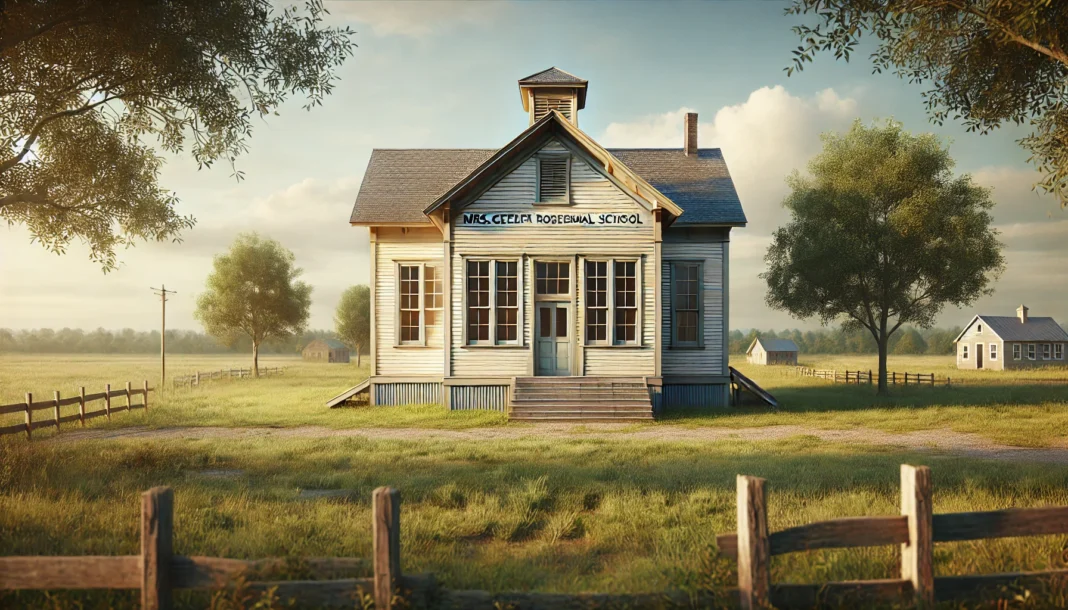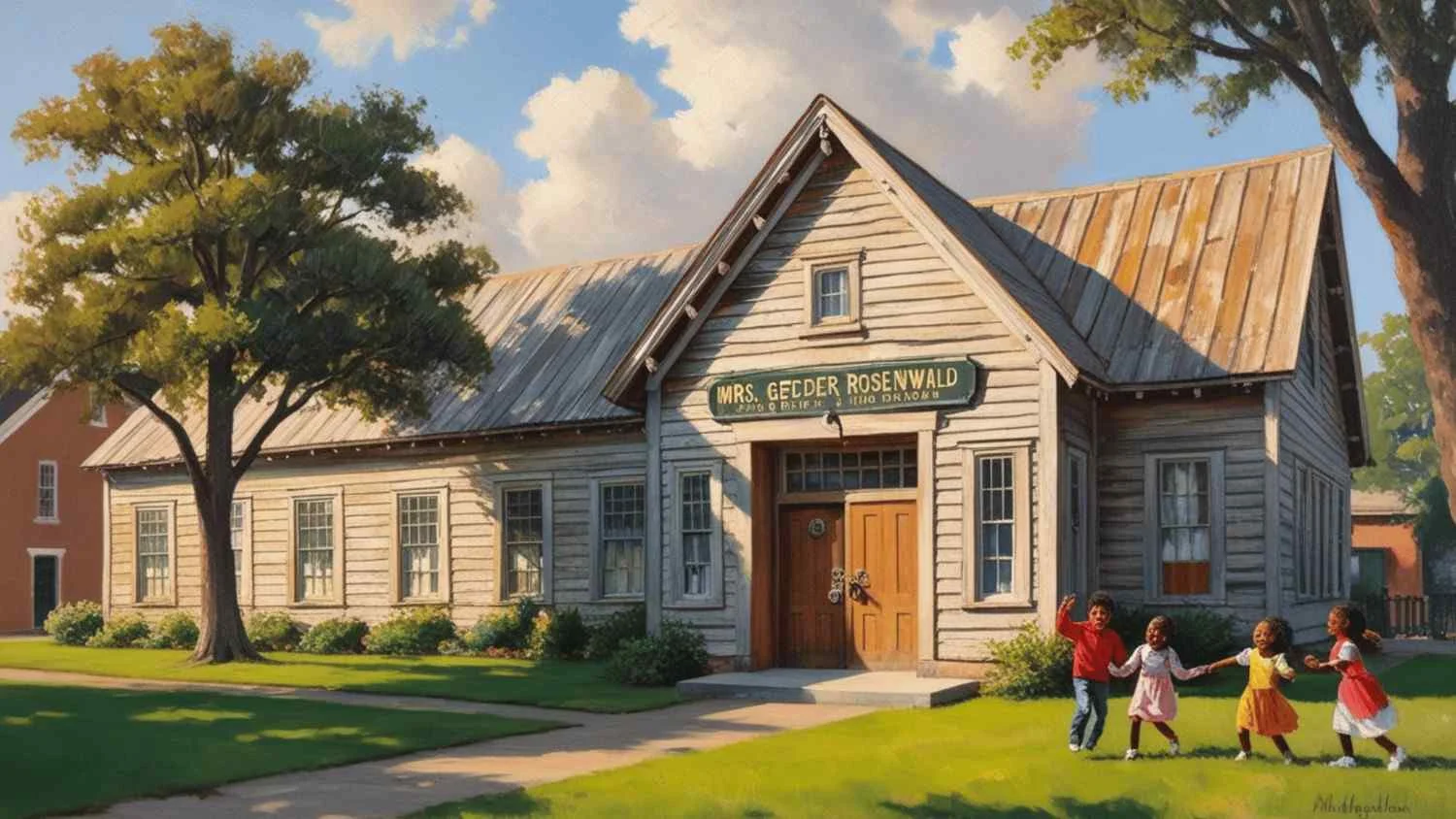
In the tapestry of American education, there are threads that shine brighter than others – threads that represent hope, perseverance, and the unwavering belief in the power of knowledge. One such golden thread is the story of the Mrs. Geeder Rosenwald School, a beacon of learning that stood tall in the face of adversity and continues to inspire generations.
The Birth of a Dream

Picture this: It’s the early 1920s, and the air is thick with change. The United States is grappling with the aftermath of World War I, the echoes of the Roaring Twenties are just beginning to reverberate, and in the South, a quiet revolution is taking place in education.
Enter Julius Rosenwald, a name that might not roll off the tongue like Rockefeller or Carnegie, but a philanthropist whose impact on African American education was nothing short of monumental. Rosenwald, the president of Sears, Roebuck and Company, had a vision – to build schools for African American children across the rural South.
But this isn’t just Rosenwald’s story. It’s the story of communities coming together, of dreams taking shape in wood and nails, and of one particular school that would bear the name of a remarkable woman: Mrs. Geeder.
Who Was Mrs. Geeder?
Ah, Mrs. Geeder. Her name might not be in history books, but in the hearts of those who knew her, she was nothing less than a force of nature. A local educator with a passion that could light up the darkest of classrooms, Mrs. Geeder was the embodiment of dedication.
Legend has it that she could silence a rowdy class with a single raised eyebrow and inspire a love for learning with just a few kind words. Her students didn’t just learn reading, writing, and arithmetic – they learned about dignity, respect, and the importance of reaching for the stars, even when those stars seemed impossibly far away.
The Rosenwald School Program: A Ray of Hope
The Rosenwald School program was more than just a construction project – it was a lifeline. In an era when educational opportunities for African American children were scarce and often subpar, these schools represented a chance at a brighter future.
Between 1917 and 1932, over 5,000 Rosenwald Schools were built across 15 states. Each one was a testament to the power of collaboration, with funding coming from the Julius Rosenwald Fund, local African American communities, and public funds.
- Determination: Students walking miles each day, eager to learn
- Innovation: Teachers making the most of limited resources
- Community: Parents and neighbors coming together to support the school
A Day in the Life at Mrs. Geeder Rosenwald School
Imagine, if you will, a crisp autumn morning in the 1930s. The sun is just peeking over the horizon as children make their way along dusty roads, books clutched tightly to their chests. The Mrs. Geeder Rosenwald School comes into view – a simple yet dignified building that holds the key to their futures.
Inside, the day begins with the Pledge of Allegiance, followed by a song. Perhaps it’s “Lift Every Voice and Sing,” its lyrics of hope and perseverance echoing through the halls. Then, it’s time for lessons.
In one corner, younger students practice their letters, carefully forming each curve and line. In another, older students pore over history books, learning about a world beyond their small town. And at the front, Mrs. Geeder moves from group to group, her presence like a guiding light.
But it’s not all books and blackboards. These Rosenwald Schools were designed with large windows to let in natural light – a luxury in those days – and to serve as community centers. After school hours, the building might host:
- Adult literacy classes
- Community meetings
- Social gatherings and performances
The Impact: Beyond Bricks and Mortar
The true measure of the Mrs. Geeder Rosenwald School’s success wasn’t in its architecture or even in its curriculum. It was in the lives it touched and the futures it shaped.
Consider these statistics:
- Rosenwald Schools are credited with increasing literacy rates among African Americans in the South by an estimated 5%.
- Many graduates went on to become teachers themselves, perpetuating the cycle of education.
- The schools fostered a sense of pride and community ownership that transcended their educational purpose.
But numbers only tell part of the story. The real impact was in the individual stories – the child who discovered a love for science and went on to become a doctor, the shy student who found their voice and became a community leader, the family that saw education as their ticket to a better life.
Challenges and Triumphs
Of course, the road wasn’t always smooth. The Mrs. Geeder Rosenwald School, like many of its counterparts, faced numerous challenges:
- Limited Resources: Books were often secondhand, and supplies were precious.
- Segregation: The very need for these schools was born out of a deeply unfair system.
- Maintenance: Keeping the school in good repair was an ongoing community effort.
Yet, in the face of these obstacles, the school thrived. It became a symbol of what could be achieved through determination and collective effort. The challenges, in many ways, only served to strengthen the resolve of the community.
The Legacy Lives On
As the years passed, the landscape of American education changed. The landmark Brown v. Board of Education decision in 1954 officially ended school segregation, and many Rosenwald Schools, including the Mrs. Geeder School, eventually closed their doors.
But the story doesn’t end there. The legacy of these schools – and of educators like Mrs. Geeder – continues to inspire. Today, efforts are underway to preserve and restore many Rosenwald Schools as historical landmarks. They serve as powerful reminders of a time when education was not a right but a hard-won privilege.
The Mrs. Geeder Rosenwald School may no longer stand in its original form, but its spirit lives on in:
- Scholarships: Named in honor of Mrs. Geeder and other educators
- Community Programs: Inspired by the school’s role as a community center
- Educational Initiatives: Focused on providing quality education to underserved communities
Lessons for Today
In our current era of educational debates and digital learning, what can we learn from the story of the Mrs. Geeder Rosenwald School?
- The Power of Community: When people come together for a common cause, amazing things can happen.
- The Importance of Dedicated Educators: Teachers like Mrs. Geeder can change lives.
- The Value of Perseverance: In the face of adversity, education can be a powerful tool for change.
- The Need for Equality: While progress has been made, the fight for equal educational opportunities continues.
Remembering and Moving Forward
As we celebrate the legacy of the Mrs. Geeder Rosenwald School, we’re not just looking back – we’re looking forward. We’re asking ourselves:
- How can we honor the spirit of these schools in our modern educational system?
- What can we do to ensure that every child, regardless of background, has access to quality education?
- How can we support and celebrate the Mrs. Geeders of today – those educators who go above and beyond?
A Call to Action
The story of the Mrs. Geeder Rosenwald School is more than just a historical footnote – it’s a call to action. It challenges us to:
- Support education initiatives in underserved communities
- Recognize and appreciate the hard work of educators
- Preserve the history of institutions like Rosenwald Schools
- Continue the fight for educational equality
In Conclusion
The Mrs. Geeder Rosenwald School may have been built of wood and nails, but its foundation was laid with hope, its walls were raised with determination, and its roof was crafted from dreams. It stood as a testament to what can be achieved when people believe in the power of education and work together to make those beliefs a reality.
As we face the educational challenges of the 21st century, let’s draw inspiration from this remarkable legacy. Let’s channel the spirit of Mrs. Geeder, the vision of Julius Rosenwald, and the determination of countless students who walked through those schoolhouse doors, eager to learn and ready to change the world.
For in the end, the greatest legacy of the Mrs. Geeder Rosenwald School isn’t found in history books or preserved buildings – it’s found in the lives it touched, the minds it opened, and the future it helped to shape. And that, dear readers, is a legacy worth celebrating and continuing.
You Can Also Read Here Key Details Revealed in C.W. Park’s USC Lawsuit: A Deep Dive into Academic Controversy


